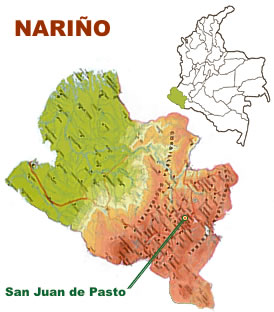
|

|
|
 |


|
 |
NARIÑO
Inhabitant: Nariñense
The department of Nariño was named after Antonio Nariño,
one of the most outstanding leaders in Colombia's fight for
independence. The department was founded in 1904.
It is located in the south-western region of Colombia. Its surface
covers an area of 33,268 square kilometres. It is bordered in the north
and the east by the departments of Cauca and Putumayo, in the west by
the Pacific Ocean and in the south by the Republic of Ecuador.
Three different regions form its land: the Andean region, the Amazon
region and the plains. The impressive cordillera of the Andes
(mountain range) enters Colombia through this department in a
place called Nudo de Los Pastos. The volcanoes Galeras, Doña
Juana, Chiles and Cumbral y Azufral are found in this region.
The department is bathed by many rivers such as the Patía, the
Mataje and the Mira. There are several lakes like the Cocha. With a
capacity of 1,550 million cubic meters of water, it is the second
largest lake in the country.
The territory is crossed by the Inter-tropical zone of confluence called
the El Niño phenomenon. Because of this, its climate has extreme
temperatures.
The economy of Nariño is based mainly on services and industry,
followed by agriculture and mining.
During the Pre-Hispanic period, the region was inhabited by different
native groups such as the Quillacingas, Pastos, Iscuandés, Tumas,
Telembíes and some other tribes. The first Spaniard that traveled
through the southern zone of the Pacific was Pascual de Andagoya in
1522. He was followed by Francisco Pizarro, who arrived at the inlet of
Tumaco.
Nariño has approximately 1,800,000 inhabitants, 800,000 of which
live in the main cities of Pasto, Tumaco, Ipiales and Túquerres.
At present, the native population in the Nariño region is the
biggest in the country. They live in the department's rural zone.
The department has many pretty and interesting places to visit, such as
the majestic Sanctuary of Nuestra Señora de Las Lajas,
the lake La Cocha, the lake of Cumbal, the thermal springs of Ipiales
and La Cruz, the bay of Tumaco, the Bocagrande beach, the Sanquiana
natural park, the flora and fauna sanctuaries Galeras and La Corota
island.
Capital: San Juan de Pasto
Pasto, the capital city, is situated on the valley of Atriz at the foot
of Galeras volcano. It was founded by Lorenzo de Aldana in
1536.
Pasto has about 400,000 inhabitants. It is a picturesque city. Its
narrow streets and colonial-style houses, its museums of contemporary,
colonial, and pre-Colombian art, its craft centers, its churches and
monuments make Pasto a great tourist attraction.
At the beginning of every year, the famous Carnival of Blacks and Whites
takes place in this city and is attended by thousands of people from all
over the country.
|
